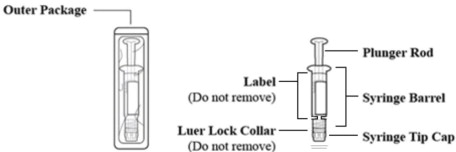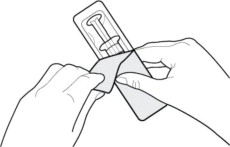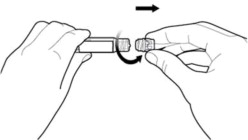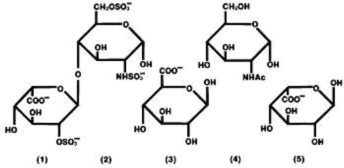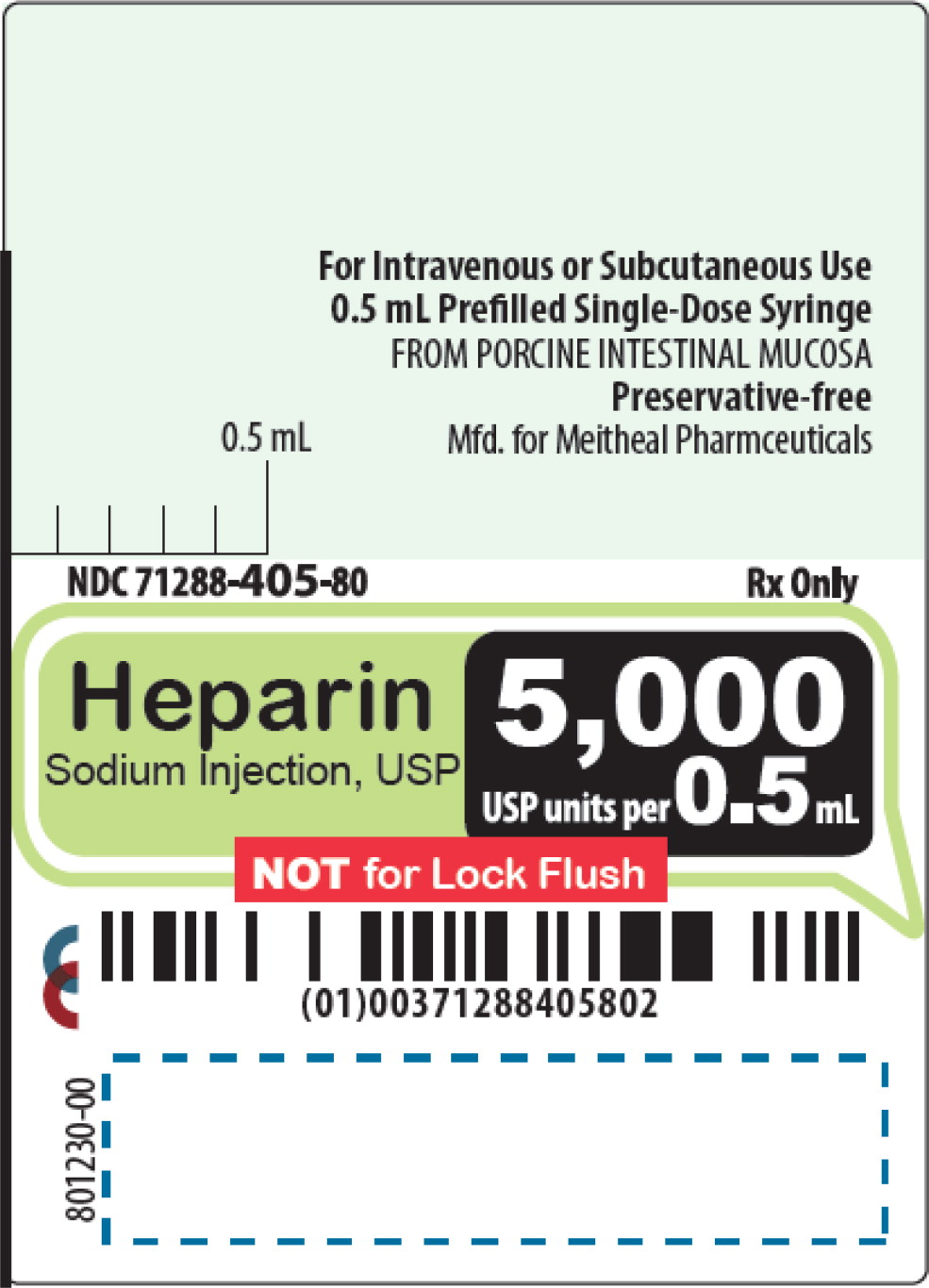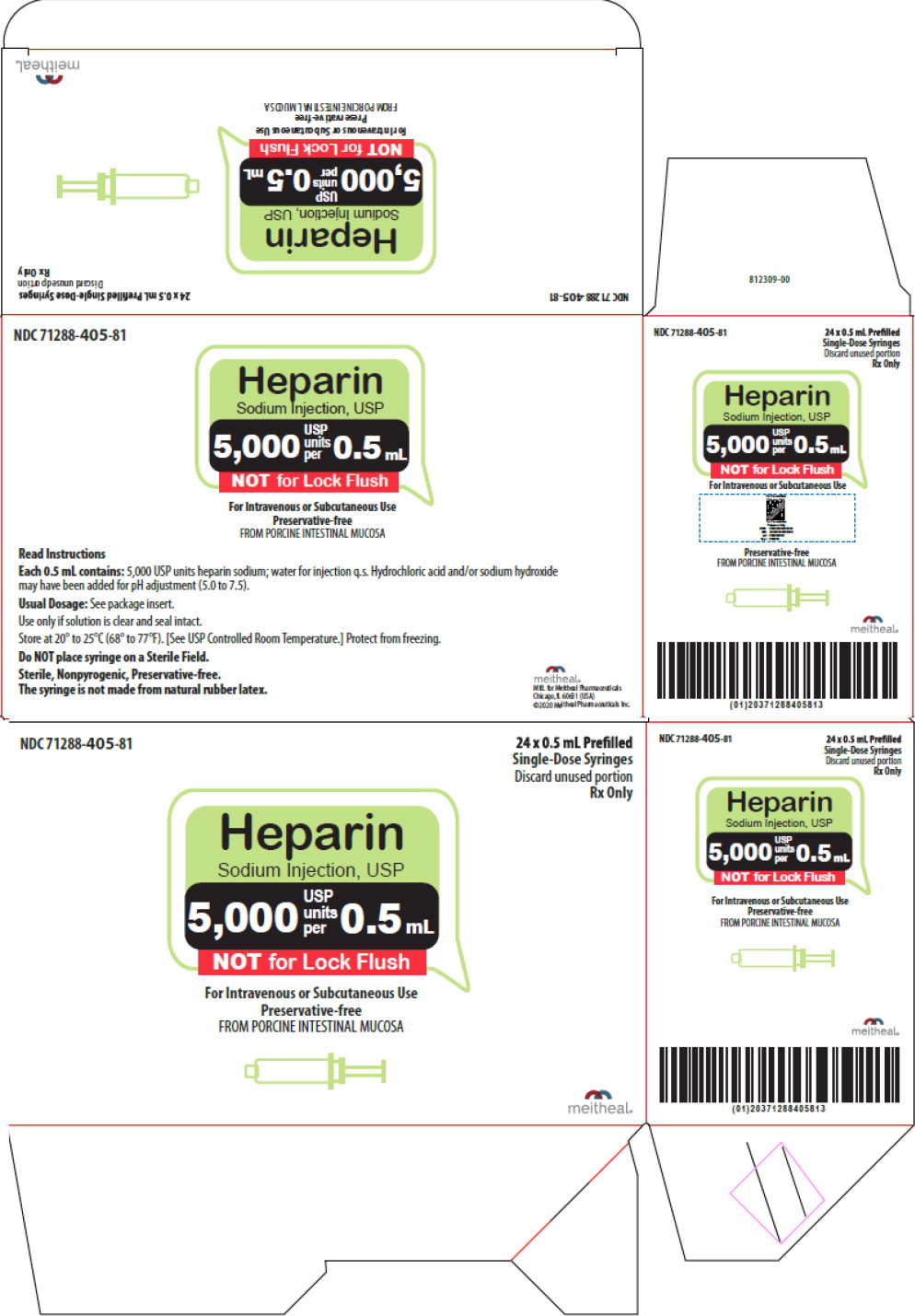HEPARIN SODIUM injection, solution
Heparin Sodium by
Drug Labeling and Warnings
Heparin Sodium by is a Prescription medication manufactured, distributed, or labeled by Meitheal Pharmaceuticals Inc., Nanjing King-Friend Biochemical Pharmaceutical Co., Ltd.. Drug facts, warnings, and ingredients follow.
Drug Details [pdf]
-
HIGHLIGHTS OF PRESCRIBING INFORMATION
These highlights do not include all the information needed to use HEPARIN SODIUM INJECTION safely and effectively. See full prescribing information for HEPARIN SODIUM INJECTION.
HEPARIN SODIUM injection, for intravenous or subcutaneous use
Initial U.S. Approval: 1939INDICATIONS AND USAGE
Heparin Sodium Injection is an anticoagulant indicated for (1)
- Prophylaxis and treatment of venous thrombosis and pulmonary embolism
- Prevention of postoperative deep venous thrombosis and pulmonary embolism in patients undergoing major abdominothoracic surgery or who, for other reasons, are at risk of developing thromboembolic disease
- Atrial fibrillation with embolization
- Treatment of acute and chronic consumptive coagulopathies (disseminated intravascular coagulation)
- Prevention of clotting in arterial and cardiac surgery
- Prophylaxis and treatment of peripheral arterial embolism
- Use as an anticoagulant in blood transfusions, extracorporeal circulation, and dialysis procedures
DOSAGE AND ADMINISTRATION
Recommended Adult Dosages:
- Therapeutic Anticoagulant Effect with Full-Dose Heparin Sodium† (2.3)
† Based on 68 kg patient. Adjust dose based on laboratory monitoring.
Deep Subcutaneous (Intrafat) Injection
Use a different site for each injectionInitial Dose 5,000 units by intravenous injection, followed by 10,000 units to 20,000 units of a concentrated solution, subcutaneously Every 8 hours
or
Every 12 hours8,000 units to 10,000 units of a concentrated solution
15,000 units to 20,000 units of a concentrated solutionIntermittent Intravenous Injection Initial dose 10,000 units, either undiluted or in 50 mL to 100 mL of 0.9% Sodium Chloride Injection, USP by intravenous injection Every 4 to 6 hours 5,000 units to 10,000 units, either undiluted or in 50 mL to 100 mL of 0.9% Sodium Chloride Injection, USP Intravenous Infusion Initial dose 5,000 units by intravenous injection Continuous 20,000 units/24 hours to 40,000 units/24 hours in 1,000 mL of 0.9% Sodium Chloride Injection, USP (or in any compatible solution) for infusion DOSAGE FORMS AND STRENGTHS
Injection: 5,000 USP units per 0.5 mL (10,000 USP units per mL) preservative-free clear solution in prefilled single-dose syringe (3)
CONTRAINDICATIONS
WARNINGS AND PRECAUTIONS
- Fatal Medication Errors: Confirm choice of correct strength prior to administration (5.1)
- Hemorrhage: Fatal cases have occurred. Use caution in conditions with increased risk of hemorrhage (5.2)
- HIT and HITT: Monitor for signs and symptoms and discontinue if indicative of HIT and HITT (5.3)
- Monitoring: Blood coagulation tests guide therapy for full-dose heparin sodium
- Monitor platelet count and hematocrit in all patients receiving heparin sodium (5.6, 5.7)
ADVERSE REACTIONS
Most common adverse reactions are hemorrhage, thrombocytopenia, HIT and HITT, injection site irritation, general hypersensitivity reactions, and elevations of aminotransferase levels. (6.1)
To report SUSPECTED ADVERSE REACTIONS, contact Meitheal Pharmaceuticals Inc. at 1-844-824-8426 or FDA at 1-800-FDA-1088 or www.fda.gov/medwatch.
DRUG INTERACTIONS
Drugs that interfere with platelet aggregation: May induce bleeding (7.2)
USE IN SPECIFIC POPULATIONS
See 17 for PATIENT COUNSELING INFORMATION.
Revised: 1/2020
-
Table of Contents
FULL PRESCRIBING INFORMATION: CONTENTS*
1 INDICATIONS AND USAGE
2 DOSAGE AND ADMINISTRATION
2.1 Preparation for Administration
2.2 Laboratory Monitoring for Efficacy and Safety
2.3 Therapeutic Anticoagulant Effect with Full-Dose Heparin Sodium
2.4 Cardiovascular Surgery
2.5 Low-Dose Prophylaxis of Postoperative Thromboembolism
2.6 Blood Transfusion
2.7 Converting to Warfarin
2.8 Converting to Oral Anticoagulants other than Warfarin
2.9 Extracorporeal Dialysis
2.10 Administration Technique
3 DOSAGE FORMS AND STRENGTHS
4 CONTRAINDICATIONS
5 WARNINGS AND PRECAUTIONS
5.1 Fatal Medication Errors
5.2 Hemorrhage
5.3 Heparin Sodium-Induced Thrombocytopenia and Heparin Sodium-Induced Thrombocytopenia and Thrombosis
5.5 Thrombocytopenia
5.6 Coagulation Testing and Monitoring
5.7 Heparin Sodium Resistance
5.8 Hypersensitivity
6 ADVERSE REACTIONS
6.1 Postmarketing Experience
7 DRUG INTERACTIONS
7.1 Oral Anticoagulants
7.2 Platelet Inhibitors
7.3 Other Interactions
8 USE IN SPECIFIC POPULATIONS
8.1 Pregnancy
8.2 Lactation
8.4 Pediatric Use
8.5 Geriatric Use
10 OVERDOSAGE
11 DESCRIPTION
12 CLINICAL PHARMACOLOGY
12.1 Mechanism of Action
12.2 Pharmacodynamics
12.3 Pharmacokinetics
13 NONCLINICAL TOXICOLOGY
13.1 Carcinogenesis, Mutagenesis, Impairment of Fertility
16 HOW SUPPLIED/STORAGE AND HANDLING
17 PATIENT COUNSELING INFORMATION
- * Sections or subsections omitted from the full prescribing information are not listed.
-
1 INDICATIONS AND USAGE
Heparin Sodium Injection is indicated for:
- Prophylaxis and treatment of venous thrombosis and pulmonary embolism;
- Prevention of postoperative deep venous thrombosis and pulmonary embolism in patients undergoing major abdominothoracic surgery or who, for other reasons, are at risk of developing thromboembolic disease;
- Atrial fibrillation with embolization;
- Treatment of acute and chronic consumptive coagulopathies (disseminated intravascular coagulation);
- Prevention of clotting in arterial and cardiac surgery;
- Prophylaxis and treatment of peripheral arterial embolism.
- Anticoagulant use in blood transfusions, extracorporeal circulation, and dialysis procedures.
-
2 DOSAGE AND ADMINISTRATION
2.1 Preparation for Administration
Confirm the choice of the correct heparin sodium injection syringe to ensure that the 1 mL syringe is not confused with a “catheter lock flush” syringe or other 1 mL syringe of incorrect strength [see Warnings and Precautions (5.1)]. Confirm the selection of the correct formulation and strength prior to administration of the drug.
When heparin sodium is added to an infusion solution for continuous intravenous administration, invert the container repeatedly to ensure adequate mixing and prevent pooling of the heparin sodium in the solution. Visually inspect parenteral drug products for particulate matter and discoloration prior to administration, whenever solution and container permit. Use only if solution is clear and the seal is intact. Do not use if solution is discolored or contains a precipitate.
Administer heparin sodium injection by intermittent intravenous injection, intravenous infusion, or deep subcutaneous (intrafat, i.e., above the iliac crest or abdominal fat layer) injection. Do not administer heparin sodium injection by intramuscular injection because of the risk of hematoma at the injection site [see Adverse Reactions (6)].
2.2 Laboratory Monitoring for Efficacy and Safety
Adjust the dosage of heparin sodium injection according to the patient's coagulation test results. Dosage is considered adequate when the activated partial thromboplastin time (aPTT) is 1.5 to 2 times normal or when the whole blood clotting time is elevated approximately 2.5 to 3 times the control value. When initiating treatment with heparin sodium injection by continuous intravenous infusion, determine the coagulation status (aPTT, INR, platelet count) at baseline and continue to follow aPTT approximately every 4 hours and then at appropriate intervals thereafter. When the drug is administered intermittently by intravenous injection, perform coagulation tests before each injection during the initiation of treatment and at appropriate intervals thereafter. After deep subcutaneous (intrafat) injections, tests for adequacy of dosage are best performed on samples drawn 4 to 6 hours after the injection.
Periodically monitor platelet counts and hematocrits during the entire course of heparin sodium therapy, regardless of the route of administration.
2.3 Therapeutic Anticoagulant Effect with Full-Dose Heparin Sodium
The dosing recommendations in Table 1 are based on clinical experience. Although dosages must be adjusted for the individual patient according to the results of suitable laboratory tests, the following dosage schedules may be used as guidelines:
Table 1: Recommended Adult Full-Dose Heparin Sodium Regimens for Therapeutic Anticoagulant Effect METHOD OF ADMINISTRATION FREQUENCY RECOMMENDED DOSE
[based on 68 kg patient]Deep Subcutaneous (Intrafat) Injection
A different site should be used for each injection to prevent development of massive hematomaInitial Dose 5,000 units by intravenous injection, followed by 10,000 units to 20,000 units of a concentrated solution, subcutaneously Every 8 hours
Or
Every 12 hours8,000 units to 10,000 units of a concentrated solution
15,000 units to 20,000 units of a concentrated solutionIntermittent Intravenous Injection Initial Dose 10,000 units, either undiluted or in 50 mL to 100 mL of 0.9% Sodium Chloride Injection, USP by intravenous injection Every 4 to 6 hours 5,000 units to 10,000 units, either undiluted or in 50 mL to 100 mL of 0.9% Sodium Chloride Injection, USP Intravenous Infusion Initial Dose 5,000 units by intravenous injection Continuous 20,000 units/24 hours to 40,000 units/24 hours in 1,000 mL of 0.9% Sodium Chloride Injection, USP (or in any compatible solution) for infusion 2.4 Cardiovascular Surgery
Patients undergoing total body perfusion for open-heart surgery should receive an initial dose of not less than 150 units of heparin sodium per kilogram of body weight. Frequently, a dose of 300 units per kilogram is used for procedures estimated to last less than 60 minutes, or 400 units per kilogram for those estimated to last longer than 60 minutes.
2.5 Low-Dose Prophylaxis of Postoperative Thromboembolism
The most widely used dosage has been 5,000 units 2 hours before surgery and 5,000 units every 8 to 12 hours thereafter for 7 days or until the patient is fully ambulatory, whichever is longer. Administer the heparin sodium by deep subcutaneous (intrafat, i.e., above the iliac crest or abdominal fat layer, arm, or thigh) injection with a fine (25- to 27-gauge) needle to minimize tissue trauma.
2.6 Blood Transfusion
Add 450 USP units to 600 USP units of heparin sodium per 100 mL of whole blood to prevent coagulation. Usually, 7,500 USP units of heparin sodium are added to 100 mL of 0.9% Sodium Chloride Injection, USP (or 75,000 USP units per 1,000 mL of 0.9% Sodium Chloride Injection, USP) and mixed; from this sterile solution, 6 mL to 8 mL are added per 100 mL of whole blood.
2.7 Converting to Warfarin
To ensure continuous anticoagulation when converting from heparin sodium injection to warfarin, continue full heparin sodium therapy for several days until the INR (prothrombin time) has reached a stable therapeutic range. Heparin sodium therapy may then be discontinued without tapering [see Drug Interactions (7.1)].
2.8 Converting to Oral Anticoagulants other than Warfarin
For patients currently receiving intravenous heparin sodium, stop intravenous infusion of heparin sodium immediately after administering the first dose of oral anticoagulant; or for intermittent intravenous administration of heparin sodium, start oral anticoagulant 0 to 2 hours before the time that the next dose of heparin sodium injection was to have been administered.
2.9 Extracorporeal Dialysis
Follow equipment manufacturers' operating directions carefully. A dose of 25 units/kg to 30 units/kg followed by an infusion rate of 1,500 units/hour to 2,000 units/hour is suggested based on pharmacodynamic data if specific manufacturers' recommendations are not available.
2.10 Administration Technique
Figure 1: Outer Packaging and Prefilled Syringe
NOTES:
- - Do not introduce any other fluid into the syringe at any time.
- - Do not dilute for intravenous push.
- - Do not re-sterilize the syringe.
- - Do not use this product on a sterile field.
- - This product is for single dose only.
- Inspect the outer packaging (blister pack) to confirm the integrity of the packaging. Do not use if the blister pack or the prefilled syringe has been damaged.
- Remove the syringe from the outer packaging. (See Figure 2)
- Visually inspect the syringe. Parenteral drug products should be inspected visually for particulate matter and discoloration prior to administration, whenever solution and container permit.
- Twist off the syringe tip cap. (See Figure 3)
- Expel air bubble(s). Adjust the dose (if applicable).
- Administer the dose ensuring that pressure is maintained on the plunger rod during the entire administration.
- Discard the syringe into the appropriate receptacle.
- 3 DOSAGE FORMS AND STRENGTHS
-
4 CONTRAINDICATIONS
The use of heparin sodium is contraindicated in patients with the following conditions:
- History of heparin sodium-induced thrombocytopenia and heparin sodium-induced thrombocytopenia and thrombosis [see Warnings and Precautions (5.3)];
- Known hypersensitivity to heparin sodium or pork products (e.g., anaphylactoid reactions) [see Adverse Reactions (6.1)]
- In whom suitable blood coagulation tests, e.g., the whole blood clotting time, partial thromboplastin time, etc., cannot be performed at appropriate intervals (this contraindication refers to full-dose heparin sodium; there is usually no need to monitor coagulation parameters in patients receiving low-dose heparin sodium);
- An uncontrolled active bleeding state [see Warnings and Precautions (5.5)], except when this is due to disseminated intravascular coagulation.
-
5 WARNINGS AND PRECAUTIONS
5.1 Fatal Medication Errors
Do not use heparin sodium injection as a “catheter lock flush” product. Heparin sodium injection is supplied in syringes containing a highly concentrated solution of 10,000 units in 1 mL (5,000 units per 0.5 mL). Fatal hemorrhages have occurred in pediatric patients due to medication errors in which 1 mL heparin sodium injection vials were confused with 1 mL “catheter lock flush” vials. Carefully examine all heparin sodium injection syringes to confirm the correct syringe choice prior to administration of the drug.
5.2 Hemorrhage
Avoid using heparin sodium in the presence of major bleeding, except when the benefits of heparin sodium therapy outweigh the potential risks.
Hemorrhage can occur at virtually any site in patients receiving heparin sodium. Fatal hemorrhages have occurred. Adrenal hemorrhage (with resultant acute adrenal insufficiency), ovarian hemorrhage, and retroperitoneal hemorrhage have occurred during anticoagulant therapy with heparin sodium [see Adverse Reactions (6.1)]. A higher incidence of bleeding has been reported in patients, particularly women, over 60 years of age [see Clinical Pharmacology (12.3)]. An unexplained fall in hematocrit, fall in blood pressure or any other unexplained symptom should lead to serious consideration of a hemorrhagic event.
Use heparin sodium with caution in disease states in which there is increased risk of hemorrhage, including:
- Cardiovascular - Subacute bacterial endocarditis, severe hypertension.
- Surgical - During and immediately following (a) spinal tap or spinal anesthesia or (b) major surgery, especially involving the brain, spinal cord, or eye.
- Hematologic - Conditions associated with increased bleeding tendencies, such as hemophilia, thrombocytopenia and some vascular purpuras.
- Patients with hereditary antithrombin III deficiency receiving concurrent antithrombin III therapy
- - The anticoagulant effect of heparin sodium is enhanced by concurrent treatment with antithrombin III (human) in patients with hereditary antithrombin III deficiency. To reduce the risk of bleeding, reduce the heparin sodium dose during concomitant treatment with antithrombin III (human).
- Gastrointestinal - Ulcerative lesions and continuous tube drainage of the stomach or small intestine.
- Other - Menstruation, liver disease with impaired hemostasis.
5.3 Heparin Sodium-Induced Thrombocytopenia and Heparin Sodium-Induced Thrombocytopenia and Thrombosis
Heparin sodium-induced thrombocytopenia (HIT) is a serious antibody-mediated reaction. HIT occurs in patients treated with heparin sodium and is due to the development of antibodies to a platelet Factor 4-heparin complex that induce in vivo platelet aggregation. HIT may progress to the development of venous and arterial thromboses, a condition referred to as heparin sodium-induced thrombocytopenia with thrombosis (HITT). Thrombotic events may also be the initial presentation for HITT. These serious thromboembolic events include deep vein thrombosis, pulmonary embolism, cerebral vein thrombosis, limb ischemia, stroke, myocardial infarction, mesenteric thrombosis, renal arterial thrombosis, skin necrosis, gangrene of the extremities that may lead to amputation, and possibly death. If the platelet count falls below 100,000/mm3 or if recurrent thrombosis develops, promptly discontinue heparin sodium, evaluate for HIT and HITT, and, if necessary, administer an alternative anticoagulant. HIT or HITT can occur up to several weeks after the discontinuation of heparin sodium therapy. Patients presenting with thrombocytopenia or thrombosis after discontinuation of heparin sodium should be evaluated for HIT or HITT.
5.5 Thrombocytopenia
Thrombocytopenia in patients receiving heparin sodium has been reported at frequencies up to 30%. It can occur 2 to 20 days (average 5 to 9) following the onset of heparin sodium therapy. Obtain platelet counts before and periodically during heparin sodium therapy. Monitor thrombocytopenia of any degree closely. If the count falls below 100,000/mm3 or if recurrent thrombosis develops, promptly discontinue heparin sodium, evaluate for HIT and HITT, and, if necessary, administer an alternative anticoagulant [see Warnings and Precautions (5.3)].
5.6 Coagulation Testing and Monitoring
When using a full dose heparin sodium regimen, adjust the heparin sodium dose based on frequent blood coagulation tests. If the coagulation test is unduly prolonged or if hemorrhage occurs, discontinue heparin sodium promptly [see Overdosage (10)]. Periodic platelet counts and hematocrits are recommended during the entire course of heparin sodium therapy, regardless of the route of administration [see Dosage and Administration (2.2)].
5.7 Heparin Sodium Resistance
Resistance to heparin sodium is frequently encountered in fever, thrombosis, thrombophlebitis, infections with thrombosing tendencies, myocardial infarction, cancer, in postsurgical patients, and patients with antithrombin III deficiency. Close monitoring of coagulation tests is recommended in these cases. Adjustment of heparin sodium doses based on anti-Factor Xa levels may be warranted.
-
6 ADVERSE REACTIONS
The following clinically significant adverse reactions are described elsewhere in the labeling:
- Hemorrhage [see Warnings and Precautions (5.2)]
- Heparin Sodium-Induced Thrombocytopenia and Heparin Sodium-Induced Thrombocytopenia and Thrombosis [see Warnings and Precautions (5.3)]
- Thrombocytopenia [see Warnings and Precautions (5.5)]
- Heparin Sodium Resistance [see Warnings and Precautions (5.7)]
- Hypersensitivity [see Warnings and Precautions (5.8)]
6.1 Postmarketing Experience
The following adverse reactions have been identified during post approval use of heparin sodium injection. Because these reactions are reported voluntarily from a population of uncertain size, it is not always possible to reliably estimate their frequency or establish a causal relationship to drug exposure.
- Hemorrhage is the chief complication that may result from heparin sodium therapy [see Warnings and Precautions (5.2)]. Gastrointestinal or urinary tract bleeding during anticoagulant therapy may indicate the presence of an underlying occult lesion. Bleeding can occur at any site but certain specific hemorrhagic complications may be difficult to detect:
- Adrenal hemorrhage, with resultant acute adrenal insufficiency, has occurred with heparin sodium therapy, including fatal cases.
- Ovarian (corpus luteum) hemorrhage developed in a number of women of reproductive age receiving short- or long-term heparin sodium therapy.
- Retroperitoneal hemorrhage
- HIT and HITT, including delayed onset cases [see Warnings and Precautions (5.3)].
- Local Irritation – Local irritation, erythema, mild pain, hematoma or ulceration may follow deep subcutaneous (intrafat) injection of heparin sodium. Because these complications are much more common after intramuscular use, the intramuscular route is not recommended.
- Histamine-like reactions – Such reactions have been observed at the site of injections. Necrosis of the skin has been reported at the site of subcutaneous injection of heparin sodium, occasionally requiring skin grafting [see Warnings and Precautions (5.3)].
- Hypersensitivity – Generalized hypersensitivity reactions have been reported, with chills, fever and urticaria as the most usual manifestations, and asthma, rhinitis, lacrimation, headache, nausea and vomiting, and anaphylactoid reactions, including shock, occurring less frequently. Itching and burning, especially on the plantar side of the feet, may occur [see Warnings and Precautions (5.8)].
- Elevations of aminotransferases – Significant elevations of aspartate aminotransferase (AST) and alanine aminotransferase (ALT) levels have occurred in patients who have received heparin sodium.
- Miscellaneous - Osteoporosis following long-term administration of high doses of heparin sodium, cutaneous necrosis after systemic administration, suppression of aldosterone synthesis, delayed transient alopecia, priapism, and rebound hyperlipemia on discontinuation of heparin sodium have also been reported.
-
7 DRUG INTERACTIONS
7.1 Oral Anticoagulants
Heparin sodium may prolong the one-stage prothrombin time. Therefore, when heparin sodium is given with dicumarol or warfarin sodium, a period of at least 5 hours after the last intravenous dose or 24 hours after the last subcutaneous dose should elapse before blood is drawn, if a valid prothrombin time is to be obtained.
7.2 Platelet Inhibitors
Drugs such as NSAIDS (including salicylic acid, ibuprofen, indomethacin, and celecoxib), dextran, phenylbutazone, thienopyridines, dipyridamole, hydroxychloroquine, glycoprotein IIb/IIIa antagonists (including abciximab, eptifibatide, and tirofiban), and others that interfere with platelet-aggregation reactions (the main hemostatic defense of heparinized patients) may induce bleeding and should be used with caution in patients receiving heparin sodium. To reduce the risk of bleeding, a reduction in the dose of antiplatelet agent or heparin sodium is recommended.
7.3 Other Interactions
Digitalis, tetracyclines, nicotine or antihistamines may partially counteract the anticoagulant action of heparin sodium. Intravenous nitroglycerin administered to heparinized patients may result in a decrease of the partial thromboplastin time with subsequent rebound effect upon discontinuation of nitroglycerin. Careful monitoring of partial thromboplastin time and adjustment of heparin sodium dosage are recommended during coadministration of heparin sodium and intravenous nitroglycerin.
Antithrombin III (human) – The anticoagulant effect of heparin sodium is enhanced by concurrent treatment with antithrombin III (human) in patients with hereditary antithrombin III deficiency. To reduce the risk of bleeding, a reduced dosage of heparin sodium is recommended during treatment with antithrombin III (human).
-
8 USE IN SPECIFIC POPULATIONS
8.1 Pregnancy
Risk Summary
There are no available data on heparin sodium injection use in pregnant women to inform a drug- associated risk of major birth defects and miscarriage. In published reports, heparin sodium exposure during pregnancy did not show evidence of an increased risk of adverse maternal or fetal outcomes in humans. No teratogenicity, but early embryo-fetal death was observed in animal reproduction studies with administration of heparin sodium to pregnant rats and rabbits during organogenesis at doses approximately 10 times the maximum recommended human dose (MRHD) of 45,000 units/ day (see Data). Consider the benefits and risks of heparin sodium injection for the mother and possible risks to the fetus when prescribing heparin sodium injection to a pregnant woman.
If available, preservative-free heparin sodium injection is recommended when heparin sodium therapy is needed during pregnancy.
The background risk of major birth defects and miscarriage for the indicated population is unknown. All pregnancies have a background risk of birth defect, loss, or other adverse outcomes. In the U.S. general population, the estimated background risk of major birth defects and miscarriage in clinically recognized pregnancies is 2-4% and 15-20%, respectively.
Data
Human Data
The maternal and fetal outcomes associated with uses of heparin sodium via various dosing methods and administration routes during pregnancy have been investigated in numerous studies. These studies generally reported normal deliveries with no maternal or fetal bleeding and no other complications.
Animal Data
In a published study conducted in rats and rabbits, pregnant animals received heparin sodium intravenously during organogenesis at a dose of 10,000 units/kg/day, approximately 10 times the maximum human daily dose based on body weight. The number of early resorptions increased in both species. There was no evidence of teratogenic effects.
8.2 Lactation
Risk Summary
There is no information regarding the presence of heparin sodium injection in human milk, the effects on the breastfed child, or the effects on milk production. Due to its large molecular weight, heparin sodium is not likely to be excreted in human milk, and any heparin sodium in milk would not be orally absorbed by a nursing child. The developmental and health benefits of breastfeeding should be considered along with the mother's clinical need for heparin sodium injection and any potential adverse effects on the breastfed child from heparin sodium injection or from the underlying maternal condition [see Use in Specific Populations (8.4)].
8.4 Pediatric Use
Pediatric dosing is not achievable with the prefilled syringe presentation. Use another heparin sodium product presentation when dosing pediatric patients.
8.5 Geriatric Use
There are limited adequate and well-controlled studies in patients 65 years and older, however, a higher incidence of bleeding has been reported in patients, particularly women, over 60 years of age [see Warnings and Precautions (5.2)]. Patients over 60 years of age may require lower doses of heparin sodium. Lower doses of heparin sodium may be indicated in these patients [see Clinical Pharmacology (12.3)].
-
10 OVERDOSAGE
Bleeding is the chief sign of heparin sodium overdosage.
Neutralization of Heparin Sodium Effect
When clinical circumstances (bleeding) require reversal of the heparin sodium effect, protamine sulfate (1% solution) by slow infusion will neutralize heparin sodium. No more than 50 mg should be administered, very slowly, in any 10-minute period. Each mg of protamine sulfate neutralizes approximately 100 USP heparin sodium units. The amount of protamine required decreases over time as heparin sodium is metabolized. Although the metabolism of heparin sodium is complex, it may, for the purpose of choosing a protamine dose, be assumed to have a half-life of about 1/2 hour after intravenous injection.
Because fatal reactions often resembling anaphylaxis have been reported with protamine, it should be given only when resuscitation techniques and treatment of anaphylactoid shock are readily available.
For additional information consult the labeling of protamine sulfate injection.
-
11 DESCRIPTION
Heparin is a heterogeneous group of straight-chain anionic mucopolysaccharides, called glycosaminoglycans, possessing anticoagulant properties. It is composed of polymers of alternating derivations of α-D-glucosamido (N-sulfated O-sulfated O-sulfated or N-acetylated) and O-sulfated uronic acid (α-L-iduronic acid or β-D-glucuronic acid).
Structure of heparin sodium (representative subunits):
Heparin Sodium Injection, USP is a sterile solution of heparin sodium derived from porcine intestinal mucosa, standardized for anticoagulant activity, in water for injection. It is to be administered by intravenous or deep subcutaneous routes. The potency is determined by a biological assay using a USP reference standard based on units of heparin sodium activity per milligram.
Each 0.5 mL of the 5,000 units per 0.5 mL preparation contains: 5,000 USP heparin sodium units (porcine); water for injection q.s. Hydrochloric acid and/or sodium hydroxide may have been added for pH adjustment (5.0 to 7.5).
-
12 CLINICAL PHARMACOLOGY
12.1 Mechanism of Action
Heparin sodium interacts with the naturally occurring plasma protein, Antithrombin III, to induce a conformational change, which markedly enhances the serine protease activity of Antithrombin III, thereby inhibiting the activated coagulation factors involved in the clotting sequence, particularly Xa and IIa. Small amounts of heparin sodium inhibit Factor Xa, and larger amounts inhibit thrombin (Factor IIa). Heparin sodium also prevents the formation of a stable fibrin clot by inhibiting the activation of the fibrin stabilizing factor. Heparin sodium does not have fibrinolytic activity; therefore, it will not lyse existing clots.
12.2 Pharmacodynamics
Various times (activated clotting time, activated partial thromboplastin time, prothrombin time, whole blood clotting time) are prolonged by full therapeutic doses of heparin sodium; in most cases, they are not measurably affected by low doses of heparin sodium. The bleeding time is usually unaffected by heparin sodium.
12.3 Pharmacokinetics
Absorption
Heparin sodium is not absorbed through the gastrointestinal tract and therefore administered via parenteral route. Peak plasma concentration and the onset of action are achieved immediately after intravenous administration.
Distribution
Heparin sodium is highly bound to antithrombin, fibrinogens, globulins, serum proteases and lipoproteins. The volume of distribution is 0.07 L/kg.
Elimination
Excretion
Heparin sodium is mainly cleared from the circulation by liver and reticuloendothelial cells mediated uptake into extravascular space. Heparin sodium undergoes biphasic clearance, a) rapid saturable clearance (zero order process due to binding to proteins, endothelial cells and macrophage) and b) slower first order elimination. The plasma half-life is dose-dependent and it ranges from 0.5 to 2 h.
Specific Populations
Geriatric patients
Patients over 60 years of age, following similar doses of heparin sodium, may have higher plasma levels of heparin sodium and longer activated partial thromboplastin times (APTTs) compared with patients under 60 years of age [see Use in Specific Populations (8.5)].
- 13 NONCLINICAL TOXICOLOGY
-
16 HOW SUPPLIED/STORAGE AND HANDLING
Heparin Sodium Injection, USP is a preservative-free clear solution available as:
NDC Heparin Sodium Injection, USP (10,000 USP units per mL) Package Factor 71288-405-81 5,000 USP units per 0.5 mL, Prefilled Single-Dose Syringe 24 syringes per carton Sterile, Nonpyrogenic, Preservative-free.
The syringe is not made with natural rubber latex. -
17 PATIENT COUNSELING INFORMATION
Hemorrhage
Inform patients that it may take them longer than usual to stop bleeding, that they may bruise and/or bleed more easily when they are treated with heparin sodium, and that they should report any unusual bleeding or bruising to their physician. Hemorrhage can occur at virtually any site in patients receiving heparin sodium. Fatal hemorrhages have occurred [see Warnings and Precautions (5.2)].
Prior to Surgery
Advise patients to inform physicians and dentists that they are receiving heparin sodium before any surgery is scheduled [see Warnings and Precautions (5.2)].
Heparin Sodium-Induced Thrombocytopenia
Inform patients of the risk of heparin sodium-induced thrombocytopenia (HIT). HIT may progress to the development of venous and arterial thromboses, a condition known as heparin sodium-induced thrombocytopenia and thrombosis (HITT). HIT and HITT can occur up to several weeks after the discontinuation of heparin sodium therapy [see Warnings and Precautions (5.3)].
Hypersensitivity
Inform patients that generalized hypersensitivity reactions have been reported. Necrosis of the skin has been reported at the site of subcutaneous injection of heparin sodium [see Warnings and Precautions (5.8), Adverse Reactions (6.1)].
Other Medications
Because of the risk of hemorrhage, advise patients to inform their physicians and dentists of all medications they are taking, including non-prescription medications, and before starting any new medication [see Drug Interactions (7.1)].
For more information concerning this drug, please call Meitheal Pharmaceuticals Inc. at 1-844-824-8426.
To report SUSPECTED ADVERSE REACTIONS, contact Meitheal Pharmaceuticals Inc. at 1-844-824-8426 or FDA at 1-800-FDA-1088 or www.fda.gov/medwatch.
meitheal®
Mfd. for Meitheal Pharmaceuticals
Chicago, IL 60631 (USA)
©2020 Meitheal Pharmaceuticals Inc.January 2020
810058-00
-
PRINCIPAL DISPLAY PANEL
Principal Display Panel – Heparin Sodium Injection, USP 5,000 USP units per 0.5 mL Syringe Label
For Intravenous or Subcutaneous Use
0.5 mL Prefilled Single-Dose Syringe
FROM PORCINE INTESTINAL MUCOSA
Preservative-free
Mfd. for Meitheal Pharmaceuticals
NDC 71288-405-80
Rx Only
Heparin Sodium Injection, USP
5,000 USP units per 0.5 mL
NOT for Lock Flush
-
PRINCIPAL DISPLAY PANEL
Principal Display Panel – Heparin Sodium Injection, USP 5,000 USP units per 0.5 mL Blister Pack Label
NDC 71288-405-80
Rx Only
Heparin Sodium Injection, USP
5,000 USP units per 0.5 mL
NOT for Lock Flush
For Intravenous or Subcutaneous Use
Preservative-free
FROM PORCINE INTESTINAL MUCOSA
0.5 mL Prefilled Single-Dose Syringe
-
PRINCIPAL DISPLAY PANEL
Principal Display Panel – Heparin Sodium Injection, USP 5,000 USP units per 0.5 mL Carton
NDC 71288-405-81
24 x 0.5 mL Prefilled Single-Dose Syringes
Discard unused portion
Rx Only
Heparin Sodium Injection, USP
5,000 USP units per 0.5 mL
NOT for Lock Flush
For Intravenous or Subcutaneous Use
Preservative-free
FROM PORCINE INTESTINAL MUCOSA
-
INGREDIENTS AND APPEARANCE
HEPARIN SODIUM
heparin sodium injection, solutionProduct Information Product Type HUMAN PRESCRIPTION DRUG Item Code (Source) NDC: 71288-405 Route of Administration INTRAVENOUS, SUBCUTANEOUS Active Ingredient/Active Moiety Ingredient Name Basis of Strength Strength heparin sodium (UNII: ZZ45AB24CA) (heparin - UNII:T2410KM04A) heparin 5000 [USP'U] in 0.5 mL Inactive Ingredients Ingredient Name Strength hydrochloric acid (UNII: QTT17582CB) sodium hydroxide (UNII: 55X04QC32I) water (UNII: 059QF0KO0R) Packaging # Item Code Package Description Marketing Start Date Marketing End Date 1 NDC: 71288-405-81 24 in 1 CARTON 04/02/2020 1 NDC: 71288-405-80 1 in 1 BLISTER PACK 1 0.5 mL in 1 SYRINGE, GLASS; Type 2: Prefilled Drug Delivery Device/System (syringe, patch, etc.) Marketing Information Marketing Category Application Number or Monograph Citation Marketing Start Date Marketing End Date ANDA ANDA212060 04/02/2020 Labeler - Meitheal Pharmaceuticals Inc. (080548348) Establishment Name Address ID/FEI Business Operations Nanjing King-Friend Biochemical Pharmaceutical Co., Ltd. 421297554 MANUFACTURE(71288-405)
© 2025 FDA.report
This site is not affiliated with or endorsed by the FDA.
